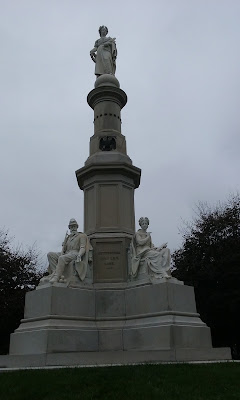I loved the following "guys". They were down for repairs.
Tuesday, October 24, 2017
Washington National Cathedral
The Washington National Cathedral is a spectacular looking cathedral. President Theodore Roosevelt laid the foundation cornerstone in 1907 and President George H. Bush was there for the placement of the "final finial". It took 83 years to finish. It and a lot of other buildings sit on a 57 acre plot. It has 112 gargoyles, 288 angels on the two west towers, and 215 stained glass windows. There are 1,500 + needlepoint pieces. It took 10,500 + pieces of glass to construct the west rose window. There are 10,650 pipes in the Great Organ. The two west towers are 234' high, and the central Gloria In Excelsis Deo tower is 301' high. There are numerous chapels. You can take an elevator to the top and walk all the way around and see the city. 220 people are interred there including President Woodrow Wilson and Helen Keller.
Sunday, October 22, 2017
Abraham Lincoln and The Gettysburg Address
This is the Soldier's National Monument. It is the spot near where Abraham Lincoln gave his Gettysburg address. The graves form half circle rows around the monument. You don't see that from the ground. It stands as a national monument to sorrow. Marble statues around the base of the monument represent History, War, Peace and Plenty. The figure of the Genius of Liberty tops the monument, holding a sword in one hand and the wreath of peace in the other and representing the constant struggle for freedom. It is a beautiful monument. The symbolism reminds me of the symbolism at the Capitol Building. The second memorial is in honor of Abraham Lincoln.
I had to add two professional pictures of the
monument. My pictures don't do it justice.
 |
| Lincoln's Gettysburg Address Memorial |
Gettysburg Soldier's National Cemetery
October 14, 2017
We went to Gettysburg twice. The first time on a tour bus with other senior missionaries. There were so many tour buses, cars, and people all over the place. It took all us old people so long to get off and on the bus when the tour guide, (who was very good), stopped us, that it was hard to get a "feel" of the place. The second time, just Greg and I went. We got there as early as we could, we skipped the visitor's center, took a back road and found a parking lot next to the Soldier's National Cemetery. It felt very sacred, sad, beautiful, and patriotic.
Gettysburg residents became concerned with the poor condition of soldiers' graves scattered over the battlefield and at hospital sites, and pleaded for state support to purchase a portion of the battlefield to be set aside as a final resting place for the defenders of the Union cause. The result is the Soldiers' National Cemetery. Removal of the Union dead to the cemetery began in the fall of 1863, and it was dedicated on November 19, 1863. The dedication ceremony featured orator Edward Everett and included solemn prayers, songs, dirges to honor the men who died at Gettysburg. Yet, it was President Abraham Lincoln who provided the most notable words in his two-minute long address, The Gettysburg Address, eulogizing the Union soldiers buried at Gettysburg and reminding those in attendance of their sacrifice for the Union cause, that they should renew their devotion "to the cause for which they gave the last full measure of devotion.."
We went to Gettysburg twice. The first time on a tour bus with other senior missionaries. There were so many tour buses, cars, and people all over the place. It took all us old people so long to get off and on the bus when the tour guide, (who was very good), stopped us, that it was hard to get a "feel" of the place. The second time, just Greg and I went. We got there as early as we could, we skipped the visitor's center, took a back road and found a parking lot next to the Soldier's National Cemetery. It felt very sacred, sad, beautiful, and patriotic.
Gettysburg residents became concerned with the poor condition of soldiers' graves scattered over the battlefield and at hospital sites, and pleaded for state support to purchase a portion of the battlefield to be set aside as a final resting place for the defenders of the Union cause. The result is the Soldiers' National Cemetery. Removal of the Union dead to the cemetery began in the fall of 1863, and it was dedicated on November 19, 1863. The dedication ceremony featured orator Edward Everett and included solemn prayers, songs, dirges to honor the men who died at Gettysburg. Yet, it was President Abraham Lincoln who provided the most notable words in his two-minute long address, The Gettysburg Address, eulogizing the Union soldiers buried at Gettysburg and reminding those in attendance of their sacrifice for the Union cause, that they should renew their devotion "to the cause for which they gave the last full measure of devotion.."
Just a number.
 |
These markers were in the cemetery identifying
losses by state or military units. There are a lot
of them.
|
The following three pictures are the Pennsylvania
Memorial. It deserves a note of it's own, because
the battle was in her state, and it sits in the spot
where the Union Army held the Confederate
Army on the second day.

























































